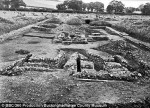 The Yewden Villa in the Thames Valley was extensively excavated in 1912. Archaeologists at the time determined that it was a high status Roman villa occupied during the 3rd and 4th centuries A.D. The artifacts, pottery and human remains uncovered at the site were packed into 300 boxes and stored at Buckinghamshire County Museum, then the site was reburied and allowed to revert to a wheat field.
The Yewden Villa in the Thames Valley was extensively excavated in 1912. Archaeologists at the time determined that it was a high status Roman villa occupied during the 3rd and 4th centuries A.D. The artifacts, pottery and human remains uncovered at the site were packed into 300 boxes and stored at Buckinghamshire County Museum, then the site was reburied and allowed to revert to a wheat field.
Although the site remains a field today with no visible Roman structures, the stored boxes and the detailed field reports of head archaeologist Alfred Cocks have recently been rediscovered. Archaeologists today, however, are interested in an aspect that aroused little comment a hundred years ago: the skeletons of 97 infants found buried on the grounds of the villa.
 It’s common to find a few burials at villas, and since infant mortality was so high, children are often among them. But to have nearly a hundred bodies in a residential area is unheard of, especially when all of them are around the same age: neonates. The best way to tell how old an infant was when he died is to measure the bones, which can pinpoint the age of the baby to within 2 weeks. All of these babies died at around 40 weeks gestation, so right at birth.
It’s common to find a few burials at villas, and since infant mortality was so high, children are often among them. But to have nearly a hundred bodies in a residential area is unheard of, especially when all of them are around the same age: neonates. The best way to tell how old an infant was when he died is to measure the bones, which can pinpoint the age of the baby to within 2 weeks. All of these babies died at around 40 weeks gestation, so right at birth.
If they had died of natural causes, it stands to reason there would be a variety of ages among the remains. The sameness strongly suggests mass infanticide. Archaeologists now think that all these babies may have been the children of a workforce on the site and thus deliberately killed.
Archaeologist Dr Jill Eyers said: “The only explanation you keep coming back to is that it’s got to be a brothel.”
With little or no effective contraception, unwanted pregnancies could have been common at Roman brothels, explained Dr Eyers, who works for Chiltern Archaeology. […]
“There is no other site that would yield anything like the 97 infant burials,” said Dr Simon Mays, a skeletal biologist at English Heritage’s Centre for Archaeology, who has been investigating the finds.
Prostitutes in Roman brothels were often slaves, so by law their children would also have belonged to the master, and given the business model, they would be very likely to get pregnant on a regular basis. Another less likely theory is that the building was used as a imperial supply depot. Many writing implements were found on the site indicating a literate workforce, and there were a large number of kilns used for drying corn. If many of those workers were female, they might have had to kill their babies to keep their jobs.
Cock’s 1921 report (World War I interrupted its publishing) described the grounds as “littered” with the remains of babies, but no markers seem to have been left for them.
“A few were laid at length, but the majority were evidently carried and buried wrapped in a cloth or garment, huddled in a little bundle, so that the head was almost central, and the knees above it,” the report said.
“As nothing marked the position of these tiny graves, a second little corpse was sometimes deposited on one already in occupation of a spot, apparently showing that these interments took place secretly, after dark.”